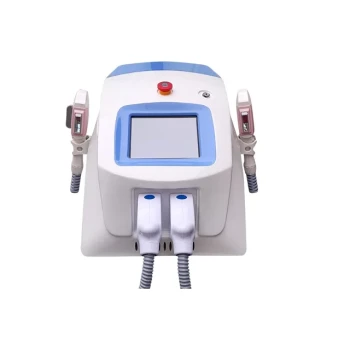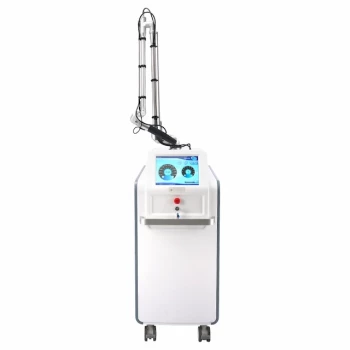At its core, an IPL machine uses gentle pulses of broad-spectrum light to disrupt the hair growth cycle. The light energy is absorbed by the pigment in the hair, which then heats the follicle and puts it into a resting phase. As a result, existing hairs naturally shed over the next one to two weeks, and with continued treatment, the follicle is discouraged from producing new hair, leading to a gradual reduction in hair growth.
Unlike methods that only trim or pull out existing hair, IPL targets the root of the problem—the follicle itself. The technology is designed not for immediate, one-time removal, but for progressively reducing hair regrowth over several weeks, leading to significantly smoother skin for longer periods.
How IPL Technology Works on a Deeper Level
To truly understand what an IPL device does, you need to look at the interaction between light, pigment, and the natural cycle of your hair.
The Critical Role of Melanin (Pigment)
The entire process hinges on melanin, the pigment that gives your hair (and skin) its color. The light emitted by an IPL device is specifically absorbed by this dark pigment.
Think of it like wearing a black shirt on a sunny day—it absorbs more heat than a white shirt. The dark melanin in the hair shaft acts like that black shirt, efficiently absorbing the light energy.
Converting Light to Heat at the Root
Once absorbed, the light energy instantly converts into heat. This heat travels down the hair shaft to the root, or follicle.
The thermal energy gently damages key structures within the follicle responsible for hair growth. This damage doesn't destroy the follicle but rather stuns it, pushing it into a dormant or "resting" phase.
Why Multiple Treatments are Necessary
IPL is only effective when the hair is in its active growth phase (known as the anagen phase). At any given time, only a fraction of your body's hairs are in this stage.
Other hairs are in a transitional or resting phase, where they are no longer connected to the follicle in a way that can transmit the heat effectively. This is why you must use the IPL device repeatedly over several weeks—to catch each hair as it enters its active growth phase.
Understanding the Trade-offs and Limitations
While effective, IPL technology has specific requirements and limitations that are crucial to understand for both safety and success.
It's Hair Reduction, Not Permanent Removal
The most common misconception is that IPL provides permanent hair removal. The correct term is permanent hair reduction.
The treatments significantly reduce the number of active hair follicles, but some may eventually recover and require periodic maintenance sessions (e.g., once every month or two) to maintain smoothness.
The Contrast is Key: Skin Tone and Hair Color
Because the technology relies on the light being absorbed by dark hair pigment, the ideal scenario is a high contrast between hair color and skin tone.
IPL is most effective on dark hair and light-to-medium skin tones. It is generally ineffective on very light blonde, red, or grey hair, which lacks sufficient melanin to absorb the light.
Crucially, IPL can be unsafe for very dark skin tones. The high concentration of melanin in the skin can absorb the light energy, pulling it away from the hair follicle and creating a risk of burns, discoloration, or scarring.
Consistency Is Not Optional
Results are directly tied to your adherence to the treatment schedule. Skipping sessions means you will miss the growth cycles of many hair follicles, which will lead to patchy results and a longer overall treatment timeline.
Making the Right Choice for Your Goal
To decide if an IPL machine is the right tool for you, consider your specific objective and physical characteristics.
- If your primary focus is convenient, long-term hair reduction at home: IPL is an excellent technology, provided your skin tone and hair color are a suitable match for the device.
- If you have very light hair (blonde, red, grey) or a very dark skin tone: IPL is unlikely to be effective and may be unsafe. You should explore professional alternatives like in-clinic laser or electrolysis after a formal consultation.
- If your goal is the most complete and permanent removal possible: Investigating a series of treatments from a licensed professional using medical-grade lasers may yield more comprehensive results.
Understanding the science behind the light empowers you to choose the right path for your unique situation.
Summary Table:
| Key Aspect | What It Means for You |
|---|---|
| How It Works | Light pulses target hair pigment (melanin), heating the follicle to stunt growth. |
| Best For | Light to medium skin tones with dark hair (high contrast). |
| Result Type | Permanent hair reduction, not permanent removal. |
| Treatment Schedule | Consistent sessions over several weeks are required for best results. |
Ready to integrate professional-grade aesthetic technology into your practice?
For medical aesthetics clinics and premium beauty salons, choosing the right equipment is the foundation of successful treatments and client satisfaction. BELIS specializes in providing advanced, reliable, and safe medical aesthetic equipment, including professional IPL systems.
We help you enhance your service offerings, improve treatment outcomes, and grow your business. Let's discuss how our technology can meet your specific needs.
Contact our experts today for a personalized consultation.
Related Products
- IPL SHR Hair Removal Machine for Permanent Hair Removal
- Clinic Use IPL and SHR Hair Removal Machine with Nd Yag Laser Tattoo Removal
- Multifunctional Laser Hair Growth Machine Device for Hair Growth
- IPL SHR+Radio frecuency machine
- Multifunctional Laser Hair Growth Machine Device for Hair Growth
People Also Ask
- How quickly do you see IPL results? A Realistic Timeline for Clearer Skin
- Does IPL hair removal actually work? Achieve Long-Term Hair Reduction
- What should I look for in an IPL machine? Key Features for Effective Hair Removal
- What is intense pulsed light good for? A Versatile Solution for Sun Spots, Redness, and Hair
- Does IPL hair removal really work? Unlock Long-Term Hair Reduction with Science



















